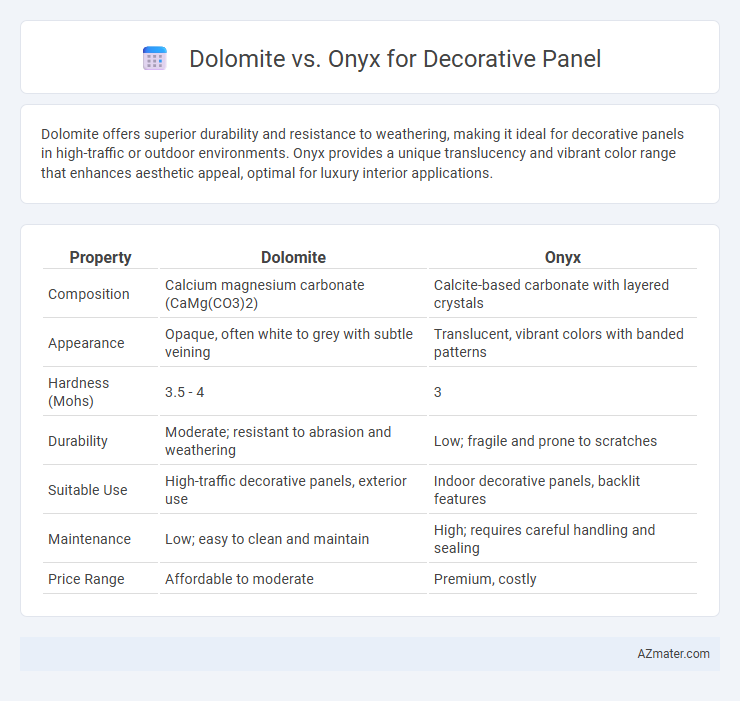Dolomite offers superior durability and resistance to weathering, making it ideal for decorative panels in high-traffic or outdoor environments. Onyx provides a unique translucency and vibrant color range that enhances aesthetic appeal, optimal for luxury interior applications.
Table of Comparison
| Property | Dolomite | Onyx |
|---|---|---|
| Composition | Calcium magnesium carbonate (CaMg(CO3)2) | Calcite-based carbonate with layered crystals |
| Appearance | Opaque, often white to grey with subtle veining | Translucent, vibrant colors with banded patterns |
| Hardness (Mohs) | 3.5 - 4 | 3 |
| Durability | Moderate; resistant to abrasion and weathering | Low; fragile and prone to scratches |
| Suitable Use | High-traffic decorative panels, exterior use | Indoor decorative panels, backlit features |
| Maintenance | Low; easy to clean and maintain | High; requires careful handling and sealing |
| Price Range | Affordable to moderate | Premium, costly |
Introduction to Decorative Stone Panels
Decorative stone panels such as Dolomite and Onyx are prized for their unique textures and aesthetic appeal in interior design. Dolomite offers durability and a matte finish, making it suitable for high-traffic areas, while Onyx is valued for its translucency and vibrant veining, ideal for feature walls and backlit installations. Both materials enhance the visual impact of spaces, combining natural beauty with functional strength in architectural applications.
What is Dolomite? Key Features
Dolomite is a sedimentary carbonate rock composed primarily of the mineral dolomite, known for its durability and resistance to weathering, making it ideal for decorative panels. Key features include its smooth texture, natural beige to gray tones, and excellent ability to maintain structural integrity under environmental stress. Its high density and low porosity enhance both aesthetic appeal and long-term performance in interior and exterior applications.
What is Onyx? Key Features
Onyx is a translucent, banded variety of calcite known for its striking natural veining and luminous appearance, making it ideal for decorative panels. Key features include its ability to be backlit for enhanced visual impact, a smooth, polished surface, and a variety of vibrant colors ranging from white and gold to green and red. Compared to dolomite, onyx is softer and more fragile, requiring careful maintenance but offering unparalleled elegance in interior design.
Visual Appearance: Dolomite vs Onyx
Dolomite features a matte to slightly glossy surface with subtle veining patterns, offering a natural and understated elegance for decorative panels. Onyx exhibits a translucent quality with vibrant, dramatic veining and a high-gloss finish, creating a luxurious and eye-catching visual impact. The choice between Dolomite and Onyx depends on desired aesthetic, where Dolomite suits minimalist and earthy designs, while Onyx enhances spaces with bold color and light play.
Durability Comparison: Dolomite and Onyx
Dolomite exhibits superior durability compared to onyx, making it more suitable for decorative panel applications where strength and longevity are crucial. Dolomite's hardness rating on the Mohs scale typically ranges from 3.5 to 4, while onyx scores around 6.5 to 7, though onyx's crystal structure makes it more prone to scratching and chipping despite its hardness. The dense composition of dolomite provides enhanced resistance to wear, weathering, and chemical erosion, ensuring its decorative panels maintain aesthetic integrity over time.
Maintenance Requirements
Dolomite decorative panels require minimal maintenance due to their high resistance to scratches and stains, needing only regular cleaning with mild soap and water to maintain their appearance. Onyx panels demand more care because of their porosity and susceptibility to scratching, necessitating sealing treatments and gentle cleaning methods to prevent damage. Proper maintenance of each material extends longevity, with dolomite offering easier upkeep compared to the more delicate and sensitive nature of onyx.
Cost Differences Between Dolomite and Onyx
Dolomite typically costs significantly less than onyx, making it a budget-friendly option for decorative panels without sacrificing durability. Onyx, known for its translucent and luxurious appearance, commands a premium price due to its rarity and intricate patterning. Choosing between dolomite and onyx depends on budget constraints and desired aesthetic impact in interior design projects.
Best Uses for Dolomite in Decorative Panels
Dolomite is ideal for decorative panels in residential and commercial interiors due to its durability, resistance to scratches, and natural matte finish that enhances aesthetic appeal. Its high calcium magnesium carbonate content provides excellent stability and weather resistance, making it suitable for both indoor and outdoor applications such as accent walls, fireplace surrounds, and bathroom installations. The subtle color variations and ability to be polished or honed allow designers to create elegant, timeless decorative panels that blend seamlessly with various architectural styles.
Best Uses for Onyx in Decorative Panels
Onyx panels are prized for their translucent beauty and ability to be backlit, creating stunning visual effects in interior designs such as feature walls, bar fronts, and luxury countertops. Unlike dolomite, which offers durability and a matte finish suited for flooring and outdoor applications, onyx is best used in low-traffic areas where its unique veining and color variations can be showcased without risk of damage. The natural translucence of onyx makes it ideal for decorative panels in upscale environments, enhancing ambiance with a warm, luminous glow.
Choosing the Right Stone for Your Decorative Panels
Dolomite offers superior durability and resistance to acid, making it ideal for high-traffic areas where longevity is essential. Onyx provides a unique translucency and vibrant color range, perfect for creating striking, illuminated decorative panels that enhance aesthetic appeal. Selecting between dolomite and onyx depends on balancing durability requirements with design impact and lighting effects.

Infographic: Dolomite vs Onyx for Decorative Panel
 azmater.com
azmater.com